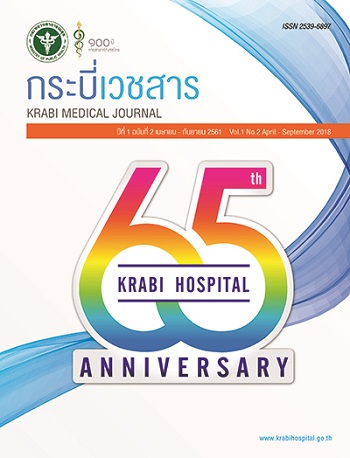Development of Clinical Practice Guideline for Weaning Protocol from Mechanical Ventilator in SICU Phatthalung Hospital
Main Article Content
Abstract
This research and development (R&D) study aimed to develop Clinical Practice Guideline (CPG) for weaning protocol from mechanical ventilator in Surgical Intensive Care Unit (SICU), Phatthalung Hospital. The research was carried out from January 2017 to February 2018, divided into 3 phases; situation analysis of weaning from mechanical ventilator in SICU, developing the CPG and evaluation. The sample was collected from the critical patients, admitted in SICU, Phatthalung Hospital. The research instruments were CPG weaning from mechanical ventilator, evaluation form of readiness for divorce, weaning ventilator record form, evaluation form of compliance, and key performance Indicators of success in divorce ventilation.
The results revealed; The weaning process divided into three distinct phases; Pre-weaning phase; assess the readiness of respirator, coordinate the medical care plan and choose the method for divorce the respirator, patient breathing and cough training properly. Weaning phase; wean, monitor parameters, vital signs and psycho support. Weaning outcome phase; assess the patient condition, the readiness, provide nursing care before removing the airway, monitor the patient’s weaning abilities and outcome. The weaning outcome showed; the success rate for weaning from mechanical ventilator increased from 29.8% to 44.2%, reducing ventilator days from 12 to 8.6. Moreover, the health care cost per time was decreased statistically
significant. In conclusion, the CPG for weaning protocol from mechanical ventilator used by the weaning process is divided into three distinct time point increase success rate of weaning from mechanical ventilator, reducing ventilator day, the health care cost per time and improve the quality of care.
Article Details
บทความนิพนธ์ต้นฉบับจะต้องผ่านการพิจารณาโดยผู้ทรงคุณวุฒิที่เชี่ยวชาญอย่างน้อย 2 ท่าน แบบผู้ทรงคุณวุฒิ และผู้แต่งไม่ทราบชื่อกันและกัน (double-blind review) และการตีพิมพ์บทความซ้ำต้องได้รับการอนุญาตจากกองบรรณาธิการเป็นลายลักษณ์อักษร
ลิขสิทธิ์
ห้ามนำข้อความทั้งหมดหรือบางส่วนไปพิมพ์ เว้นว่าได้รับอนุญาตจากโรงพยาบาลเป็นลายลักษณ์อักษร
ความรับผิดชอบ
เนื้อหาต้นฉบับที่ปรากฏในวารสารเป็นความรับผิดชอบของผู้เขียน ทั้งนี้ไม่รวมความผิดพลาดอันเกิดจากเทคนิคการพิมพ์
References
ณฐนนท์ ศิริมาศ, ปิยรัตน์ โสมศรีแพง, สุพางค์พรรณ พาดกลาง และ จีรพร จักษุจินดา. (2557). การพัฒนาระบบการดูแลหญิงตั้งครรภ์ในการป้องกันภาวะตกเลือดหลังคลอดในโรงพยาบาลสกลนคร. วารสารการพยาบาลและการดูแลสุขภาพ. 32(2):37-46.
ปนัดดา เสือหรุ่น, อรพรรณ โตสิงห์, สุพร ดนัยดุษฏีกุล และอรอุมา ชัยวัฒน์. (2558). ศึกษาปัจจัยเสี่ยงต่อการใช้เครื่องช่วยหายใจนานในผู้ป่วยหลังผ่าตัดช่องท้องระยะวิกฤติ. วารสารสภาการพยาบาล. 30(4):107-120.
วิจิตรา กุสุมภ์. (2556). การพยาบาลผู้ป่วยภาวะวิกฤต: แบบองค์รวม. ห้างหุ้นส่วนสามัญนิติบุคคล สหประชาพาณิชย์.
ศุภลักษ์ คูณศรี, ทวีศักดิ์ กสิผล, ดวงกมล วัตราดุล และรัชนี นามจันทรา. (2558). ผลของรูปแบบการหย่าเครื่องช่วยหายใจร่วมกับแรงสนับสนุนจากครอบครัวต่อความสำเร็จและระยะเวลาที่ใช้ในการหย่าเครื่องช่วยหายใจในผู้ป่วยที่มีภาวะการหายใจล้มเหลว. วารสารพยาบาลโรคหัวใจและทรวงอก. 26(1):73–88.
สมใจ สายสม และนรลักษณ์ เอื้อกิจ. (2557). ผลของการหย่าเครื่องช่วยหายใจอย่างต่อเนื่องต่อความสำเร็จและระยะเวลาในการหย่าเครื่องช่วยหายใจ. วารสารพยาบาลโรคหัวใจและทรวงอก. 25(1):54–68.
สาวรีย์ ปัญเศษ, อำภาพร นามวงศ์พรหม และน้ำอ้อย ภักดีวงศ์. (2555). ความรู้และการปฏิบัติของพยาบาลเกี่ยวกับกระบวนการหย่าเครื่องช่วยหายใจในโรงพยาบาลพระนั่งเกล้า. วารสารสมาคมพยาบาล สาขาภาคตะวันออกเฉียงเหนือ. 30(2):131–139.
เอกรินทร์ ภูมิพิเชฐ, ไชยรัตน์ เพิ่มพิกุล. (2553). Critical care: at difficult time. กรุงเทพมหานคร : สมาคมเวชบำบัด วิกฤตแห่งประเทศไทย.
อรอุมา ชัยวิวัฒน์และคณะ. (2553). การหย่าเครื่องช่วยหายใจในผู้ป่วยที่มาทำผ่าตัดในช่องท้อง. Journal med associate thai. 93(8):930–6.
American Association of Critical-Care Nurse’s: AACN’s. (1994). AACN Protocols for Practice: Care of Mechanically Ventilated Patients. แหล่งที่มา : https://books.google.co.th/books. สืบค้นเมื่อ มกราคม 2560.
Boles JM, Bion J, Connors A, Herridge H, Marsh B, Melote C, Pearl R, Silverman H, Stanchina M, Vieillard-Baron A, Welte T. (2007). Weaning from mechanical ventilation. European Respiratory Journal; 29(5):1033–56.
Brochard L., Thille AW., (2009). What is the proper approach to liberating the weak from mechanical ventilation?. Crit Care Med; 37(10);410-5.
Chen CJ, Lin CJ, Tzeng YL, Hsu LN. (2009). Successful mechanical ventilation weaning experiences at respiratory care centers. J Nurs Res. 17(2):93–101.
Doenges ME, Moorhouse MF and Murr AC (2002). Nursing Care Plans. 6th ed. Philadelphia : Lippincott William & Wilkins.
Knebel AR, Shekleton ME, Burns S, Clochesy JM, Hanneman SK and Ingersoll GL. (1994). Weaning From mechanical ventilation: concept development. American Journal of Critical Care. 3(6):416-20.
Knebel AR, Shekleton M, Burns S, Clochesy J, Hanneman S. (1998). Weaning From Mechanical Ventilator Support : refinement of a model. American Journal of Critical Care.7(2):149-52.
Mary Jo Grap, Dale Strickland, Laura Tormey, Kim Keane, Shannon Lubin, Joanne Emerson, et al. (2003). Collaborative Practice: Development, Implementation, and Evaluation of a Weaning Protocol for Patients Receiving Mechanical Ventilation. American Journal of Critical Care. 12(5):454-460.
Ventilator หอผู้ป่วยพิเศษ 6 โรงพยาบาลสุไหงโกลก. ภาวะแทรกซ้อนจากการใช้เครื่องช่วยหายใจ. My Ready Web. Recieve from : Engine by myreadyweb.com จาก http://ventilator6.
myreadyweb.com/article/topic-27767.html


